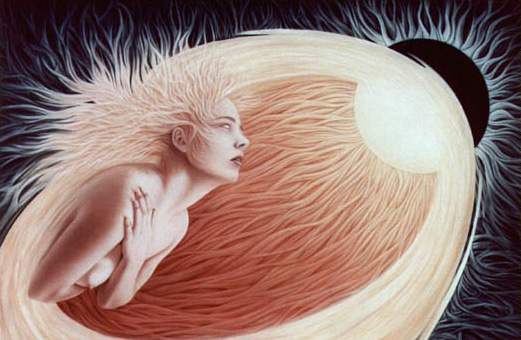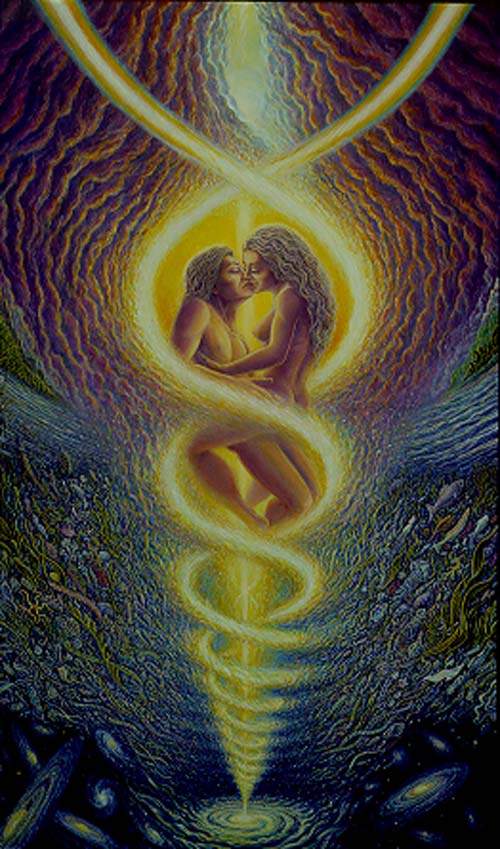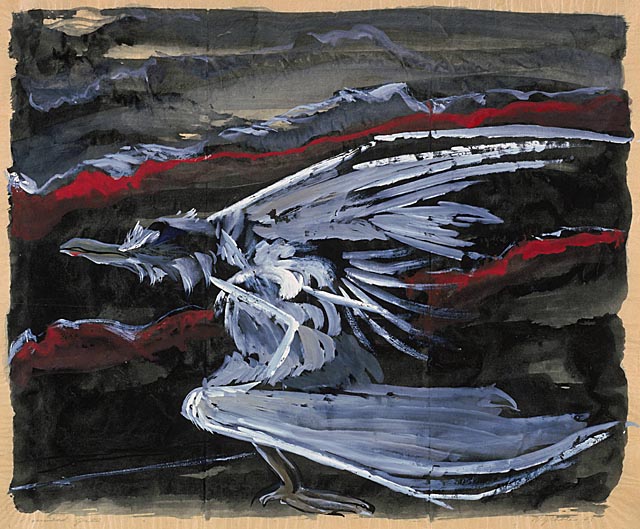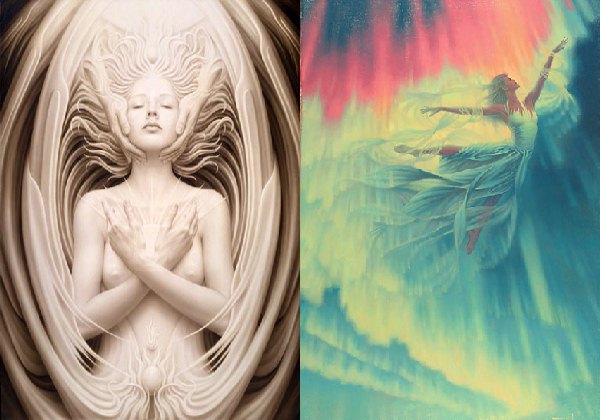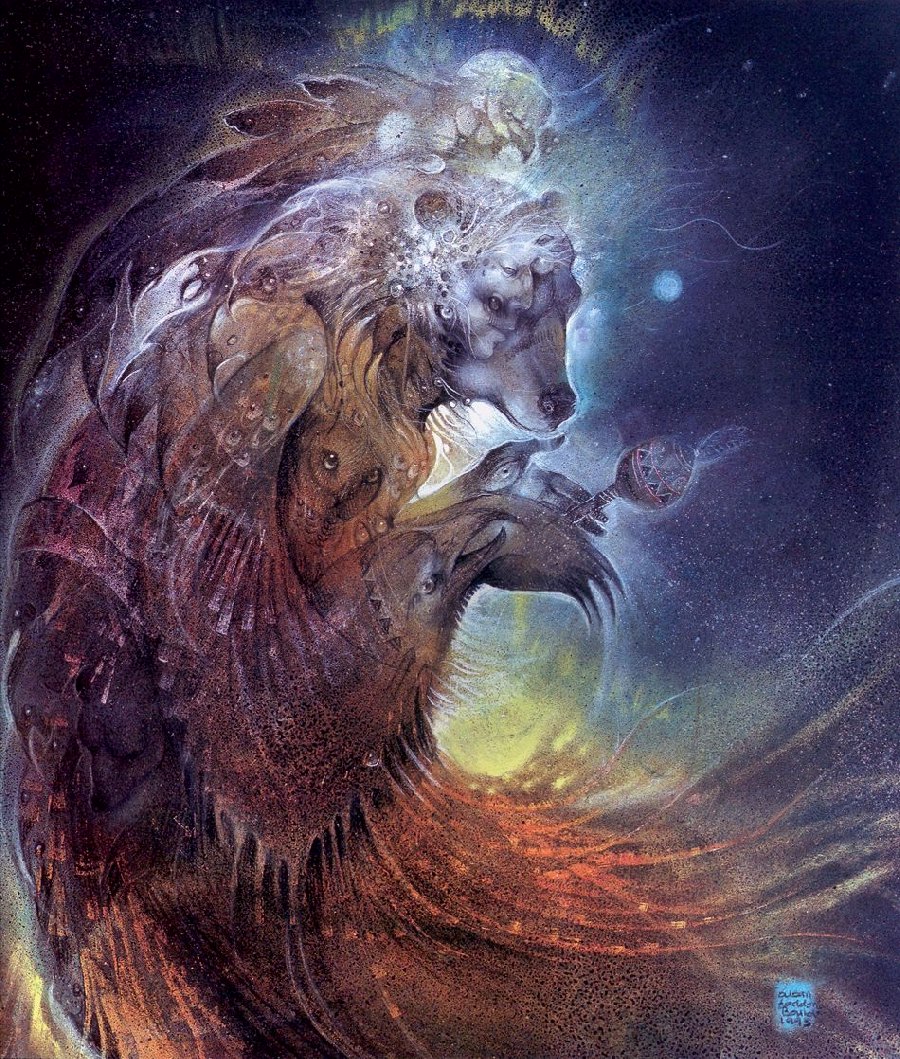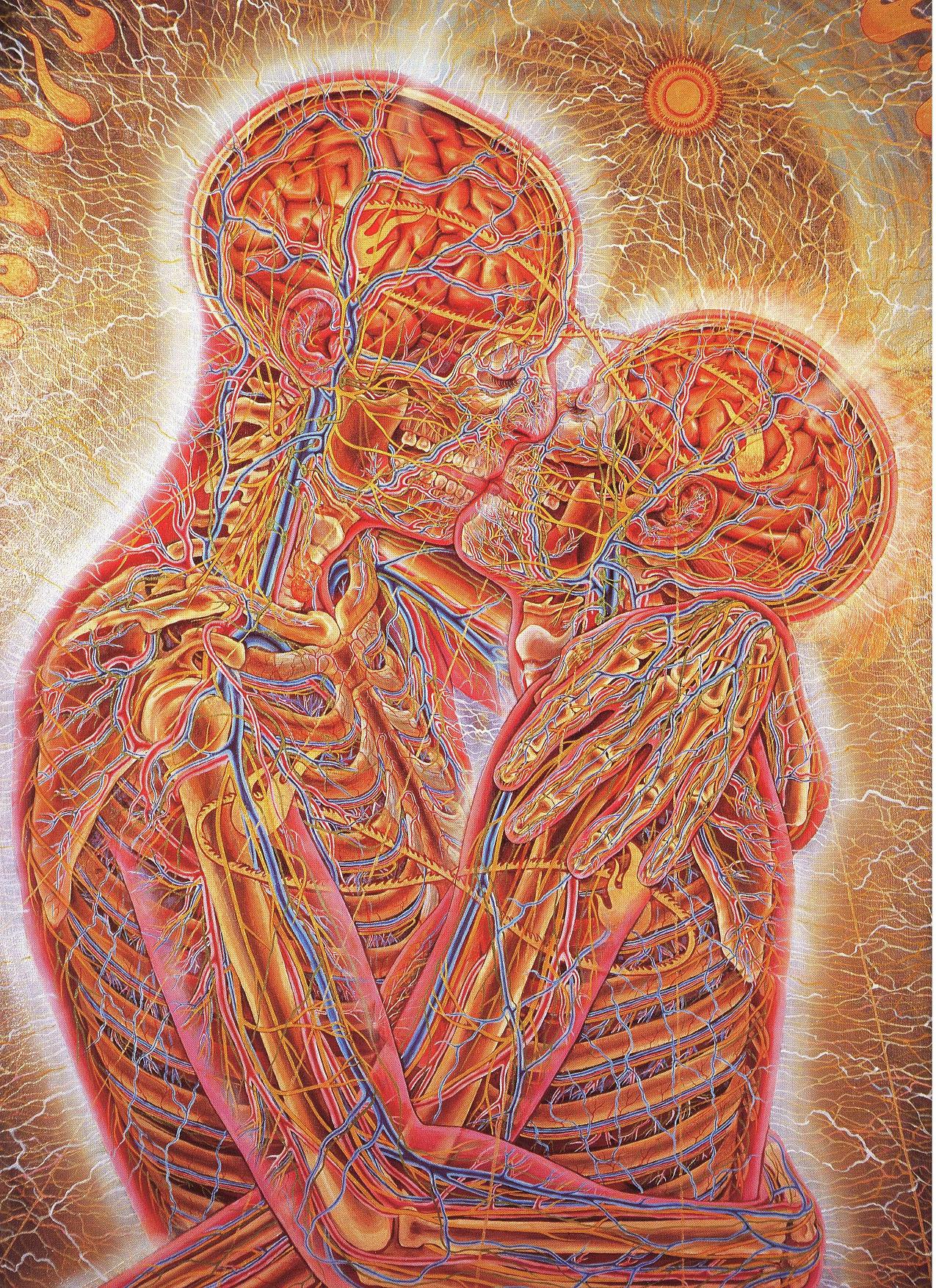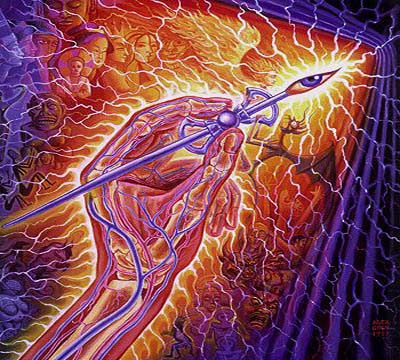| Visionary Art
The Art History Archive - Art Movements
Transcendental ArtVisionary art isn't so much a movement as it is a theme. The style of the individual artists will vary radically, but their common theme is their attempt to portray the world beyond physical sight and to overlap mystical and spiritual ideas. Visionary art purports to transcend the physical and scientific world and give the audience a virtual vision (hence the name Visionary Art) of what the world might look like if we could see spiritual and mystical things in our every day life. The type of mystical energies portrayed in Visionary Art varies from artist to artist, but the four elements (water, fire, earth and wind), love, lust, holy, unholy, positive and negative forces are all reasonably common.
This theme isn't new either. William Blake, Hieronymus Bosch, Salvador Dalν, Max Ernst, Gustave Moreau, Remedios Varo, Frida Kahlo, Edward Burne Jones, Samuel Palmer are notable examples of artists who dealt with the theme of overlapping the real world with an imagined world of mystical energies. Some artists, like William Blake, even claimed to talk to angels and claimed they could see into this other world. The Vienna School of Fantastic Realism, which includes Ernst Fuchs and Arik Brauer, is also a source of inspiration to some Visionary artists. Modern examples of Visionary artists include: Pablo Amaringo
Most Visionary artists have active spiritual lives, engaging in a variety of organized religion as well as more New Age ideas about spirituality. Some Visionary artists even draw upon psychedelic experiences. How the artists express themselves can vary wildly as quite a few of the artists are self-taught, and even academics have difficulties describing Visionary art.
"[With Visionary Art] it is difficult to know where to start and where to stop. Recognized trends have all had their fantastic component, so demarcation is apt to be fuzzy." - Walter Schurian, professor at the University of Munster. Morris Graves of the Pacific Northwest School of Art is an excellent example of how Visionary art can vary wildly as he was an expressionist and his work was largely influenced by East Asian philosophy and mysticism, aiming to create works reminiscent of Chinese landscape paintings, but did so using a thick impasto applied with a palette knife. Graves' style varies dramatically from more popular artists like A. Andrew Gonzalez (below left) and Jonathon Earl Bowser (below right) who have a tendency to add a layer of beauty and eroticism to their work. Bowser for example, who describes his work as Mythic Naturalism, is interested in dreamscapes and connections between the real world and the mythological, spending much of his time painting mythological women in fantastical settings. A. Andrew Gonzalez takes this a step further to create rapturous images of men and women surrounded by fields of holy (almost orgasmic) energy.
This theme of spiritual eroticism seems to continue in works by Alex Grey and other Visionary artists, but there are also many Visionary artists who depict landscapes and animals as more spiritual things. Susan Seddon-Boulet is an excellent example (below).
Visionary art is being touted quite a bit online. Brigid Marlin founded the Society for the Art of Imagination (an online portal for Visionary art events), Laurence Caruana's Paris-based "The Visionary Revue" draws attention to lesser known artists and discusses the more scholarly aspects of Visionary art, Jon Beinart's "The Surreal Visionary Art Forum" is a networking tool for Visionary artists. Laurence Caruana also argues that Visionary art is an identifiable art movement, despite its wide differences in style and method. If you compare it to Fantasy Art and Surrealism it certainly seems reasonable to consider Visionary Art as its own movement. To learn more on this topic read Laurence Caruana's Manifesto of Visionary Art.
|
|
What Is Visionary Art?
By Alex Grey. The artist's mission is to make the soul perceptible. Our scientific, materialist culture trains us to develop the eyes of outer perception. Visionary art encourages the development of our inner sight. To find the visionary realm, we use the intuitive inner eye: The eye of contemplation; the eye of the soul. All the inspiring ideas we have as artists originate here. The visionary realm embraces the entire spectrum of imaginal spaces from heaven to hell, from the infinitude of forms to formless voids. The psychologist James Hillman calls it the imaginal realm. Poet William Blake called it the divine imagination. The aborigines call it the dreamtime; and Sufis call it alam al-mithal. To Plato, this was the realm of the ideal archetypes. The Tibetans call it the sambhogakaya the dimension of inner richness. Theosophists refer to the astral, mental, and nirvanic planes of consciousness. Carl Jung knew this realm as the collective symbolic unconscious. Whatever we choose to call it, the visionary realm is the space we visit during dreams and altered or heightened states of consciousness. Every sacred art tradition begins with the visionary. "Divine canons of proportion," mystic syllables, and sacred writing were all realized when the early wisdom masters and artists received the original archetypes through visionary contact with the divine ground. After a sacred archetype has been given form as a work of art, it can act as a focal point of devotional energy. The artwork becomes a way for viewers to access or worship the associated transcendental domain. In sacred art, from calligraphy to icons, the work itself is a medium: a point of contact between the spiritual and material realms.
The Role of ArtOur inner world the life of our imagination with its intense feelings, fears, and loves guides our intentions and actions in the world. Our inner world is the only true source of meaning and purpose we have. Art is the song of this inner life. Arts key role in the human drama is that of a "great convincer." The artist posits one myth, religion, or ideology over another, yet also always expresses the raw passion and evolutionary force of the inner world itself. The artist attempts to make inner truths visible, audible, or sensible in some way, by manifesting them in the external, material world (through drawing, painting, song, etc.). To produce their finest works, artists lose themselves in the flow of creation from their inner worlds. The visionary artist creatively expresses her or his personal glimpses of the Divine Imagination. Every work of art embodies the vision of its creator and simultaneously reveals a facet of the collective mind. Art history shows each successive wave of vision flowing through the world's artists. Artists offer the world the pain and beauty of their souls as a gift to open the eyes of the collective and heal it. Our exposure to technological innovations and diverse forms of sacred art gives artists at the dawn of the twenty-first century a unique opportunity to create more integrative and universal spiritual art than ever before.
The Visionary TraditionA complete historical account of the global visionary art tradition would fill volumes. The sixteen thousand-year-old cave paintings of human/animal hybrids, such as the Sorcerer of Trois Freres, are a good starting point. Much ancient shamanic art, such as African ritual masks and aboriginal rock and bark paintings, clearly depict visionary dreamtime wanderings and encounters in the lower and upper worlds. A visionary art history lesson would include representations of mythic deities and demons: the Mayan feathered serpent; Egyptian and Greek sphinxes; and Indian, Balinese, and Thai portrayals of many-limbed, many-headed beings housed in complex mandalas. One of the earliest known Western mystic visionary artists was Hildegard of Bingen, a twelfth-century German abbess. While enveloped by a fiery inner light, she was told to "speak and write not according to human speech or human inventiveness, but to the extent that you see and hear those things in the heavens above in the marvelousness of God." The icons created from her visions are direct and authentic gifts of spirit. Perhaps the most famous visionary artist was the fifteenth-century painter Hieronymous Bosch, who portrayed an extraordinary array of grotesque beings, tortured souls in hell, and angels guiding the saved to the light of heaven. His Garden of Delights is one of the strangest paintings in the world an encyclopedia of metamorphic plant/animal/human symbolism. Pieter Bruegel was touched with the same visionary madness when he created Fall of the Rebel Angels and Triumph of Death an amazing landscape featuring a coffin go-kart and armies of skeletons herding the struggling masses. Northern and Italian Renaissance artists like Grunewald, Durer, and Michelangelo delineated the revelations of Christian mysticism with searing, Gothic realism. Our historical sketch of visionary art would have to include the seventeenth-century alchemical engravings of Johann Daniel Mylius and mystics like Jacob Boehme and Robert Fludd, who detailed complex mandalic philosophical maps pointing to union with the divine. William Blake, the nineteenth-century mystic artist and poet, conversed with angels and received painting instructions from discarnate entities. Blake published his own books of art and poetry, which revealed an idiosyncratic mysticism arising from his inner perception of religious subjects. He resisted conventional religious dogma, proclaiming that "all religions are one." The characters in Blake's paintings and engravings seem akin to those of Renaissance masters Michelangelo, Raphael, and Durer yet are softened with a peculiar magic. His artwork exalts an ideal realm of inspiration that he termed the "divine imagination." Blake's work laid the foundations for the nineteenth-century Symbolist movement that included such artists as Gustav Moreau, Odilon Redon, Jean Delville, and Frantisek Kupka. The realm of visionary art also embraces Modernist Abstraction like the works of Kupka, Klee, and Kandinsky; Surrealist or Fantastic Realist art; and Idealist work like Blake's. The twentieth-century Surrealists operated in a territory without clear moral order: a dreamship adrift on the ocean of the unconscious. Artists like Max Ernst, Salvador Dali, Hans Arp, Hans Bellmer, Stanislav Szukalski, Juan Miro, Leonora Carrington, Remedios Varo, and Frida Kahlo mixed images from childhood memories, adult desires and fears, sex and violence wherever the creative currents led them. The visions of the Surrealists help to define a dream realm where any bizarre juxtaposition is possible. A profound truth resides in such strangeness, for these visions can shock us into deepening our acknowledgement and appreciation of the Great Mystery. The Russian painter Pavel Tchelitchew was one of the great visionary artists of the twentieth century (his obsession with anatomy and mysticism relates to my own work). Tchelitchew's paintings evolved through metamorphic symbolism to x-ray anatomical figures glowing with inner light, and eventually progressed to luminous, abstract networks. Perhaps the most widely respected visionary painter of the twentieth century is Ernst Fuchs, whose highly detailed and symbolic works are often based on biblical and mythological subjects. Fuchs combines the technical mastery of Durer and Van Eyck with the imagination of Bosch and Blake in a completely personal fantastic realism. Fuchs has had a widespread and profound influence on many of the greatest contemporary visionary artists. The masterful Mati Klarwein, Robert Venosa, De Es Schwertberger, Olga Spiegel, Philip Rubinov-Jacobson, and many others count him a key teacher or inspirational force. The post-World War II Vienna school of Fantastic Realism included artist friends of Ernst Fuchs, like Arik Brauer, Anton Lehmdon, Wolfgang Hutter, and Rudolph Hausner. In 1940s America, the artists Ivan Albright, George Tooker, Paul Cadmus, Peter Blume, and Hyman Bloom were known as Magic Realist painters. The psychedelic sixties spawned a new kind of poster art, leading many painters in a visionary direction. In the 1960s and 70s, a loosely associated group of California visionary painters Joseph Parker, Cliff McReynolds, Clayton Anderson, Gage Taylor, Nick Hyde, Thomas Akawie, Bill Martin, and Sheila Rose were published by Pomegranate Art Books. Pomegranate has also featured the shamanically inspired work of Susan Seddon Boulet. A more visually aggressive psychedelic pop surrealism energizes the work of Keith Haring, Kenny Scharf, and Robert Williams. Paul Laffoley, a painter and architect, is one of the most encyclopedic of visionary geniuses. Dystopic visions of contemporary hell worlds are stunningly portrayed in the paintings of Joe Coleman, H.R. Giger, Manuel Ocampo, and Odd Nerdrum. Visionary abstraction is articulated in beautiful infinities in the works of Allyson Grey, Bernie Maisner, and Suzanne Williams. Some of the most promising new visionary painting is by A. Andrew Gonzalez, Erial, and Guy Aichison. The archetypal mindscapes of Francesco Clemente and Ann McCoy enjoy the rare distinction of visibility and success in the contemporary art marketplace. The word "visionary" has also come to be associated with "outsider, naive, insane, and self-taught" artists, who include Adolph Wolfli, Reverend Finster, and Minnie Evans. What unites these various groups of artists is the driving force and source of their art: their unconventionally intense imaginations. Their gift to the world is to reveal "in minute particulars," as Blake would say, the full spectrum of the vast visionary dimensions of the mind.
| |
| |
